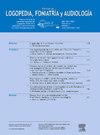Estrategias logopédicas utilizadas con niños con implante coclear durante una actividad de conversación
Q3 Nursing
引用次数: 0
Abstract
Background and objective
The study of speech-language pathologist (SLP) strategies with students with cochlear implants (CI) to promote language development has been scarcely explored, unlike the study of maternal strategies with their children and SLP strategies used with students with language disorders.
The objective of this study is to explore the strategies used by SLPs with children with CI during a conversation activity.
Materials and method
The sample consists of 7 SLPs interacting with 25 students with CI (13 girls and 12 boys) aged 5 to 7 years. Twelve questions from the conversation subtest of the PADIL protocol were formulated, and the strategies used by the SLP were analysed based on the children's errors and considering the possible influence of auditory age.
Results
It is noted that the most frequent SLP strategies were adapted repetition, identical repetition, and semantic aids. These three strategies were used to a greater extent to repair comprehension errors, non-responses, and failures to adhere to the maxim of quantity.
Conclusions
This study confirms that SLP use a wide variety of resources to elicit an appropriate response from children with CI and support their participation in conversation. The practical applications of this study highlight the importance of diversifying interaction contexts so that infants can practice their conversational skills in different communicative situations.
在谈话活动中对人工耳蜗儿童使用的语言医学策略
背景与目的不同于母亲对孩子的言语病理学策略和语言障碍学生的言语病理学策略的研究,对植入人工耳蜗(CI)学生言语病理学策略促进语言发展的研究很少。本研究的目的是探讨语言障碍儿童在会话活动中使用的策略。材料和方法样本由7名slp与25名5至7岁的CI学生(13名女孩和12名男孩)互动组成。制定了PADIL协议会话子测试中的12个问题,并根据儿童的错误并考虑听觉年龄可能的影响,分析了SLP所采用的策略。结果最常见的SLP策略是适应性重复、相同重复和语义辅助。这三种策略在很大程度上用于修复理解错误、无反应和不遵守数量准则。结论:本研究证实,语言语言干预使用多种资源来诱导CI儿童做出适当的反应,并支持他们参与对话。本研究的实际应用强调了多样化互动环境的重要性,这样婴儿就可以在不同的交际情境中练习他们的会话技能。
本文章由计算机程序翻译,如有差异,请以英文原文为准。
求助全文
约1分钟内获得全文
求助全文
来源期刊

Revista de Logopedia, Foniatria y Audiologia
Nursing-LPN and LVN
CiteScore
1.10
自引率
0.00%
发文量
28
 求助内容:
求助内容: 应助结果提醒方式:
应助结果提醒方式:


